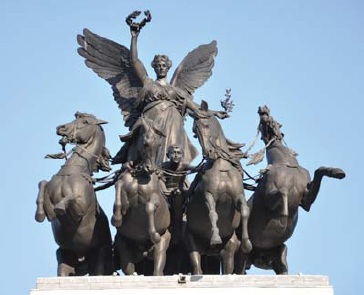
IN THE CENTRE of the roundabout at Hyde Park Corner is the Wellington Arch, which was commissioned from Decimus Burton in the 1820s as a commemoration of Britain’s victory against the French in the Napoleonic wars. It was to be in the form of a Roman triumphal arch, covered in symbolic sculpture, including trophies, statues of guardsmen and with a four-horse chariot, or quadriga, on top, but money ran out and most of the ornamentation was never added. The arch was finished in 1830 and originally stood opposite Burton’s Hyde Park Screen, and served as both an entrance to Green Park and a grand outer entrance to Buckingham Palace, George IV’s new official residence. In 1838 it was decided that there should be a national memorial to he Duke of Wellington, and that it should stand on top of what was then called the Green Park Arch, as it stood close to the Duke’s London residence, Apsley House. Matthew Cotes Wyatt was invited to produce an equestrian statue, but his design for a monumental 30-foot statue would cause much controversy. It took him six years to make, using bronze from captured French cannon. The arch had to be strengthened to take the sculpture, and the 40-ton statue was lifted into position in 1846, to much derision. It was considered to be completely out of proportion with the arch, and there were letters to the press and questions in Parliament. It was lampooned in Punch, and The Times described it some years later as being a ‘monstrosity’ and ‘of portentous ugliness’. However, to remove it would have been an insult to the Duke, so it stayed there for many years. By the 1880s the volume of traffic had increased so much that a new road system was devised, and in 1883 the arch was dismantled and moved to its present position. The statue was not replaced and, as a suitable London location could not be found, it was nearly melted down, but it was finally decided to re-erect it near the army camp at Aldershot, where it can still be seen.
A new statue of the Duke was commissioned (see below), but the question of a new sculpture for the arch was left in abeyance until in 1891 the Prince of Wales saw a plaster of a sculpture called Triumph by Adrian Jones at the Royal Academy. He thought a version of the sculpture would be suitable for the top of the arch, but, although Jones was keen on the scheme, there were no funds to pay for it. Jones worked on a scaled-up model, but it was not until 1907, when Lord Michelham offered to defray much of the cost, that things could move forward. It took the sculptor three years to produce a model of the whole group before the casting could begin in 1910. It was erected on the arch in 1912, but there was no official unveiling; King George and Queen Mary were driven to see the sculpture in situ and were introduced to the sculptor. Known as the Quadriga, it represents a boy driving four horses with the winged figure of Peace alighting in the chariot they are pulling. Jones had started sketching horses and their riders while in the Army, and they were always a speciality of his. The arch is now owned by English Heritage, who have restored it and opened it to the public. It houses displays about the arch’s history, and there are good views from the roof.

The sculptor and his assistants had tea inside the plaster model of one of the horses of the Quadriga.
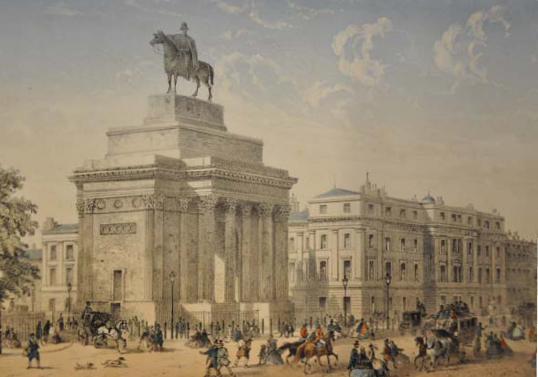
Wyatt’s colossal statue of Wellington on top of the Wellington Arch in the 1850s.
On the north side of Hyde Park Corner, facing Apsley House, is the statue of Arthur Wellesley, 1st Duke of Wellington (1769–1852), which replaced the one on the arch. It was commissioned from Sir Joseph Edgar Boehm in 1884 and was unveiled by the Prince of Wales in 1888. The Duke wears the uniform of a Field Marshal and is mounted on his favourite horse, Copenhagen, as if on the field of battle. At the corners of the red granite pedestal are bronze statues of four soldiers, a British Grenadier, a Scottish Highlander, an Irish Dragoon and a Welsh Fusilier, all in uniforms of the early part of the century and representing regiments which fought under Wellington. The bronze came from guns captured from the French.
On the west side of the roundabout is the Royal Artillery Memorial, which was erected to remember the 49,076 men of the Royal Regiment of Artillery who died in the First World War. It is the work of Charles Sargeant Jagger, who himself saw action at Gallipoli and won the Military Cross. It was unveiled in 1925 by the Duke of Connaught. The memorial consists of a stone sculpture of a howitzer on a massive plinth, with four superb bronze figures around the sides, three of which depict an officer, a gunner and a driver. The fourth one, on the north side, is the poignant recumbent figure of a dead artilleryman, his face covered by a greatcoat. Around the memorial are rather weathered carved panels showing scenes of war and weapons. Jagger intended the memorial to be seen as a permanent record of the uniforms and weapons used in the war. The representation of a dead soldier was controversial at the time, as most war memorials idealised war, whereas Jagger wanted to show the horror and violence of a war he had experienced himself. In 1949 Princess Elizabeth unveiled three bronze plaques on the south side to commemorate the 28,924 artillerymen who lost their lives in the Second World War.
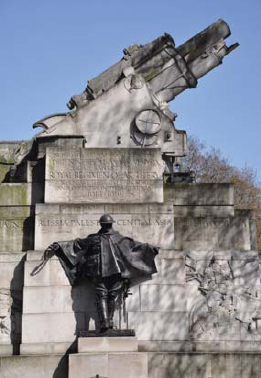
The Royal Artillery Memorial is considered to be Jagger’s masterpiece.
Curving round the south-west corner, like a boomerang, is the Australian War Memorial, which remembers the more than 100,000 Australians who lost their lives in the two world wars. The memorial, built with Australian granite, is etched with the names of thousands of place names recording the origins of those who served, and superimposed on them are the names of forty-seven battle sites where they fought. Water constantly falls over the names. The bronze insignias of the Royal Australian Navy, the Australian Army and the Royal Australian Air Force, as well as the Australian coat of arms, feature prominently. The memorial was created by the architects Tonkin Zulaikha Greer and the artist Janet Laurence. It was unveiled in 2003 by the Queen. Anzac Day is celebrated here every April.
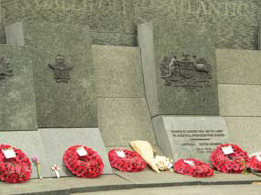
The Australian War Memorial was made with Australian granite.
In the north-east corner of the roundabout is the Machine Gun Corps Memorial, erected to commemorate those soldiers of the Corps who died in the First World War. The Corps played an important part in the war, but was disbanded in 1922 as a cost-cutting exercise. The memorial, by Francis Derwent Wood, was unveiled in 1925 by the Duke of Connaught. On top of a marble plinth is a bronze statue of a naked David, leaning on Goliath’s sword. On either side are machine guns and helmets encircled by wreaths. Underneath the main inscription are the words, ‘Saul hath slain his thousands but David his tens of thousands’, which caused much controversy at the time, with letters to The Times and a debate in the House of Commons. In 1941 the bronze parts of the memorial were removed to Aldwych underground station for safe keeping, and returned in 1946.
At the eastern end of the roundabout is the New Zealand Memorial, which was dedicated by the Queen in 2006. The memorial commemorates the long-standing bonds between the UK and New Zealand and the shared sufferings of the two countries in times of war. It consists of sixteen cross-shaped bronze sculptures decorated with words, symbols and images which represent different aspects of New Zealand life and culture. The sculptures are in two groups, with ten in front, and six behind in the form of the Southern Cross. The memorial was designed by the New Zealand sculptor Paul Dibble and the architect John Hardwick-Smith. Like the nearby Australian memorial, it is the site for Anzac commemorations in April.
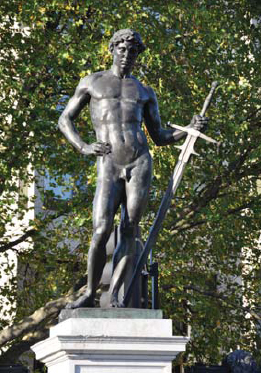
Derwent Wood’s figure of David on the Machine Gun Corps Memorial.
At the entrance to Constitution Hill are the Commonwealth Memorial Gates, which remember the nearly five million men from the Indian sub-continent, Africa and the Caribbean who served in the British Armed Forces during the two world wars. There are four piers of Portland stone, each one surmounted by a bronze urn, and with the names of Commonwealth countries inscribed on them. Alongside the gates is a pavilion, whose ceiling carries the names of seventy soldiers from those countries who won the Victoria and George Crosses. The memorial was designed by Liam O’Connor, and was dedicated by the Queen in 2002.
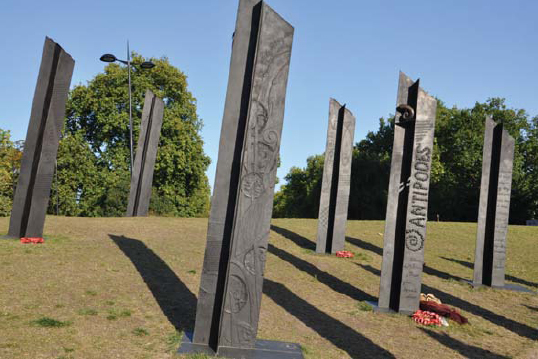
The New Zealand Memorial is the focus of the Annual Anzac commemorations.
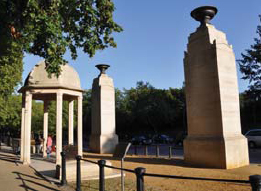
The Commonwealth Memorial Gates at the top of Constitution Hill.

The Albert Memorial is 148 feet high, but it was originally designed to be nearly 40 feet higher (see related entry on page 136).